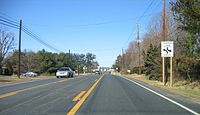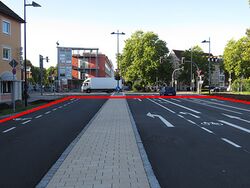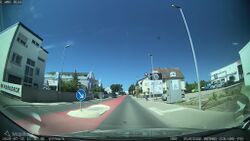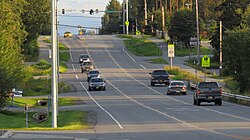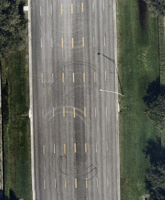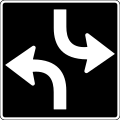Key:lanes:both_ways
| Description |
|---|
| Total number of traffic lanes available for motorised traffic in both directions at a single lane. |
| Group: highways |
| Used on these elements |
| Useful combination |
|
| Status: de facto |
| Tools for this tag |
|
Some roads have special lane for making a turn that is available in both directions, commonly called a "two-way left turn lane" (TWLT), "center left-turn lane", "center turn lane", "median turn lane", or "suicide lane".[1] Center turn lanes are especially common in suburban areas of the United States and Canada. As these countries drive on right side of the road, the center turn lane is used for turning left. Unlike with other turn lanes, a driver going in either direction may enter or exit this lane at any point along the lane. However, some jurisdictions have rules restricting how far one can travel along the lane, to discourage its use as a passing or through lane.
How to map
The road segment that has a center turn lane should be tagged lanes:both_ways=1, and lanes=* should account for the presence of this lane. turn:lanes:both_ways=* should be set to left in countries that drive on the right side of the road or right in countries that drive on the left. These tags are applicable even if there are no abutters along the road yet.
History
Originally, centre_turn_lane=yes was widely used throughout the United States to indicate a two-way left turn lane. That tag has been deprecated; most of its usage has been migrated to a tagging proposal that never came to a vote but nonetheless became established in the database. (The proposal also suggests using the same tag for transitions within intersections, but this usage's prevalence is unclear.)
Implied value
Narrow roads with oneway=no are often tagged with lanes=1 because more than one car doesn't fit laterally. In this case, the lane count is implied to be lanes:both_ways=1 and not lanes:forward=1 + lanes:forward=1 (not to mention certain editors and QA will throw an error when mapped that way), though attributes to this lane should generally be mapped without *:both_ways=* because it's clear that the attributes apply to that lane only.
Examples
United States:
lanes=8
lanes:forward=3
lanes:backward=3
lanes:reversible=2
(Reversible lanes are marked by double yellow dashes.)
- Standard signs
See also
Notes
- ↑ Originally, "suicide lane" referred to lane in the center of a highway meant for passing in both directions. Nowadays, such lanes are fairly rare.
